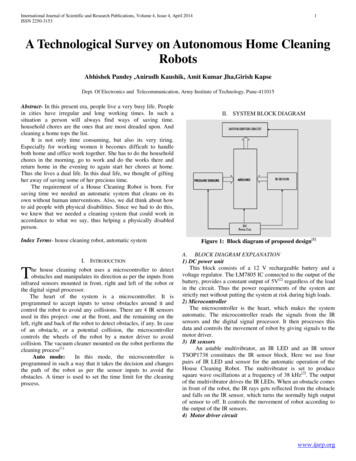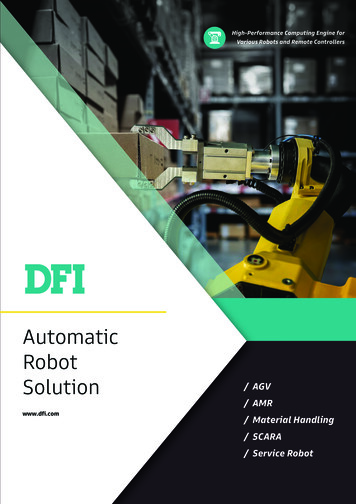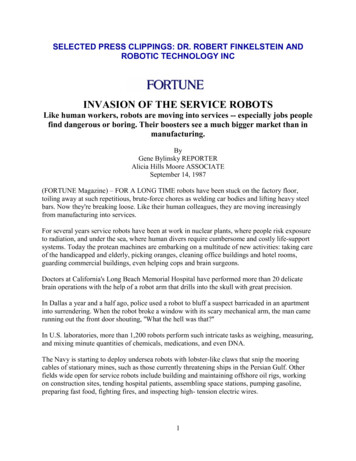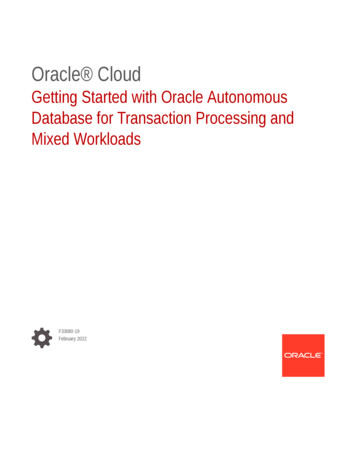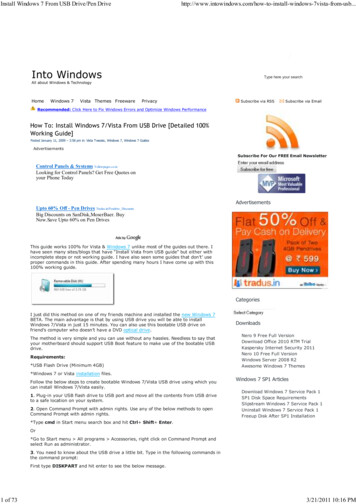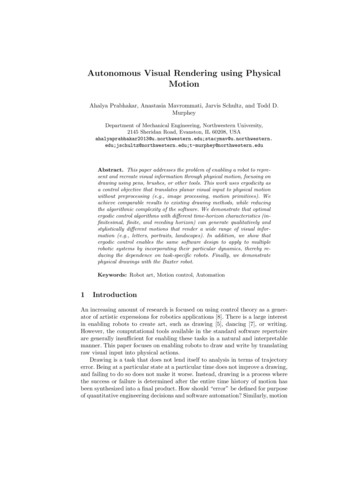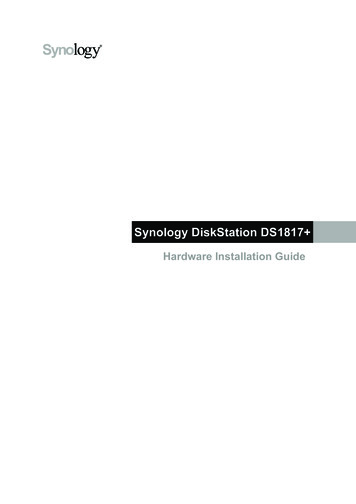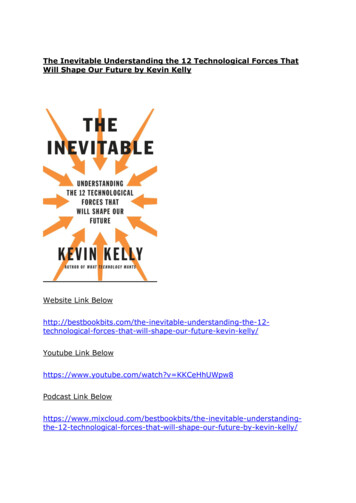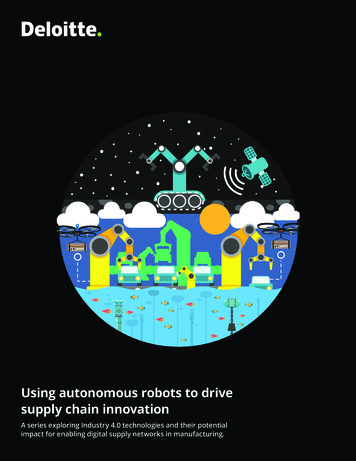
Transcription
Using autonomous robots to drivesupply chain innovationA series exploring Industry 4.0 technologies and their potentialimpact for enabling digital supply networks in manufacturing.
Using autonomous robots to drive supply chain innovationContentsWhat are autonomous robots? 04Benefits of autonomous robots in the supply chain 05Criteria for evaluation and adoption07Key levers for autonomous robots in your supply chain 10Deloitte contacts in autonomous robots and supply chain management0211
Using autonomous robots to drive supply chain innovationDo you need autonomous robots in your supply chain? Autonomousrobots can be used to improve the speed and accuracy of routine operations,particularly in warehousing and manufacturing spaces; work side-by-side withhumans for added efficiency; and reduce the risk of employee injury in dangerousenvironments.Of interest because: As the hardware and software in autonomous robotscontinues to improve, they could provide a competitive advantage to employerswithin the next 10 years. Through improvements in sensors, dexterity, artificialintelligence, and trainability, they are becoming faster and more sophisticated, andthey now include safety provisions that allow them to work collaboratively withhumans.Could improve your supply chain by: decreasing long-term costs; providinglabor and utilization stability; increasing worker productivity; reducing error rate;reducing frequency of inventory checks; optimizing picking, sorting, and storingtimes; increasing access to difficult or dangerous locations.Why not? Requires an upfront feasibility assessment based on financial return,additional skillsets, and training, as well as balancing public perception whenreplacing traditionally manual labor with capitalized assets.Deloitte recommends: Continue to monitor advancements in autonomousrobots for applicability to supply chain. Autonomous robotics have the potentialto improve operations, and they offer new opportunities to increase productivity,reduce risk, decrease cost, and improve data collection, particularly as customerexpectations and volumes of packages, shipments, and orders reach unsustainablelevels for traditional approaches.Deloitte Consulting LLP’s Supply Chain and Manufacturing Operations practice helps companies understand andaddress opportunities to apply Industry 4.0 technologies in pursuit of their business objectives. Our insights intoadditive manufacturing, the Internet of Things, and analytics enable us to help organizations reassess their people,processes, and technologies in light of advanced manufacturing practices that are evolving every day.03
Using autonomous robots to drive supply chain innovationWhat areautonomous robots?OverviewAutonomous robots are devices that areprogrammed to perform tasks with little tono human intervention or interaction. Theycan vary significantly in size, functionality,mobility, dexterity, intelligence, andcost—from robotic process automationto flying vehicles with artificial intelligence.Autonomous robots can recognize and learnfrom their surroundings and make decisionsindependently.Recent developments and outlookAutonomous robots are expected to seestrong growth over the next five years,particularly within supply chain operationsthat include lower-value, potentiallydangerous or high-risk tasks. Manufacturing,final assembly, and warehousing, forexample, are areas where robots alreadyhave a presence; continued growth ofautonomous robots could allow peoplecurrently performing these tasks to shift tomore strategic, less dangerous, and highervalue work.Autonomous robots will become moreubiquitous with advancements that makethem operate with more human-likeabilities. For example, improvements inhaptic sensors—those relating to thesense of touch—will allow robots to graspobjects ranging from fragile eggshellsto multi-surfaced metal assembly partswithout changes in programming or roboticcomponents.As artificial intelligence continues toadvance, problem solving and learninganalytics will enable robots to be responsivewith minimal human feedback. Facialrecognition software is making leapsin detecting movements in eyebrows,eyelids, and lips; through these sensors,combined with audio recognition softwarethat recognizes changes in tone, pitch, andvolume, autonomous robots can detectfrustration, urgency, or approval, and inturn, adjust actions to modify behaviorbased on live interactions.Five key developments in autonomous robotsArtificial intelligenceNavigationCost reductionsSensors and response capabilities(visual, audial, thermal, haptical)Regulatory reformand public policy04OverviewValuedrivers Increased efficiency Reduced error and returnrates Improved safety in highrisk environments Collaboration withhumans Faster delivery or productmovement rates Ability to operatein environmentsinaccessible to humansScopeMore efficient operationswithin all segments of thesupply chainTechnologysubstitutes Advanced software Simple machines or tools Human workforceAutonomous robots in the supply chainTraditionally, robots have been deployedfor executing routine and repetitive tasks,requiring complex programming for setupand implementation, while lacking the agilityto easily adjust operations. As autonomousrobots become more sophisticated, setup times are decreasing, they require lesssupervision, and they are able to work sideby side with their human counterparts. Thebenefits are expanding as autonomousrobots become capable of working aroundthe clock with more consistent levels ofquality and productivity, performing tasksthat humans cannot, should not, or do notwant to do.As the market for autonomous robotsgrows, the end-to-end supply chainoperations alignment will become morefluid. Currently, many companies that useautonomous robots have implementedthem for targeted functions within theirsupply chain, piloting various robots to verifyexpected efficiency gains. As innovativecompanies grow and expand operations,robots that build robots could be the normfor economically and efficiently optimizingmanufacturing operations.
Using autonomous robots to drive supply chain innovationBenefits of autonomousrobots in the supply chainPrimary potential benefitsIncrease efficiencyand productivityReduce error,re-work, andrisk ratesImprove safety foremployees in high-riskwork environmentsPerform lower value, mundanetasks so humans can workcollaboratively to focus on morestrategic efforts that cannot beautomatedEnhance revenue by improvingperfect order fulfillment rates,delivery speed, and ultimately,customer satisfactionValue drivers for autonomous robotsThe implementation of autonomous robotscould primarily drive value by reducingdirect and indirect operating costs andincreasing revenue potential.Autonomous robots can reduce labor costsand increase productivity by continuouslyworking around the clock without fatigue.Employee safety can be improved in highlyhazardous environments, and insuranceand injury leave costs can be reducedsignificantly.With the introduction of collaborativerobots, the days of fenced-off machines thatinteract independently are slowly fadingaway. As designs for safety and humaninteraction evolve, autonomous robots inassembly lines, factories, and warehousesare less obtrusive.Humans can work directly withcollaborative robots, easily training themwith programmable movements and thenhandling material and sorting packages sideby side with them. In material transportationenvironments, robots can seamlessly zippast each other, humans, or other movingobjects thanks to advanced collisionavoidance capabilities, which are processedas quickly as any human can react topotential accidental run-ins.¹Autonomous robots can test, pick, pack,sort, build, inspect, or transport materials ofvarious sizes and weights faster and moreefficiently than ever. Drones are alreadyused to monitor hazardous areas, includingcontrol towers, agricultural fields, and mines,and for general security and surveillance.As technologies have advanced, robot setupand implementation is getting faster andeasier than ever before. Learning modelsare becoming more intuitive, allowingany technician or employee to "train" anautonomous robot in a matter of minutes orhours. Additionally, these learning modelsallow robots to respond to sudden changes,adapt to stimuli, and improve manufacturingmethods based on build results.²Autonomous robots give growing companiesmore options for meeting capacitydemands. Available labor, particularly duringpeak holiday months, cannot always meetseasonal demands but companies can turnSecondary potential benefits(intangibles) of autonomous robots Enhanced employee value throughfocus on strategic work instead ofmundane tasks Focus on personal safety byminimizing work in hazardous areasfor employees Boosted corporate brand bysignaling leading-edge practicesand implementation of innovativetechnology Exponential learning by collectingand analyzing machine data05
Using autonomous robots to drive supply chain innovationto robots to improve operations and meetlabor demands; during the 2016 holidayseason, some warehouses even used robotsto quickly train temp workers so that theycould add value in as little as two days oftraining.³Ultimately, in material handling or processcentric scenarios, error reduction andcycle time improvement can help increasecustomer loyalty and drive sales growth forcompanies in any industry. For businessesthat rely on excellent client service, such asbanks, robotic process automation can allowpersonnel to spend significantly less timeon managing customer information andinstead focus their attention on individuallyserving clients.⁴ As supply chain operationscontinue to shift focus to direct customerneeds, autonomous robots can serve theend consumer with better service and fasterresponse times.Case study: DronesDrones are aircraft that do not have ahuman pilot on board. The aircraft iseither remotely controlled by a pilot onthe ground or autonomously controlledby computer systems on the aircraft.Drone technology has evolved from aproprietary military-only technologyto a household name, evoking interestfrom hobbyists to businesses. By 2021,the overall drone aircraft industry ispoised to grow to 10 billion.⁶This massive growth is due in part toimproved technology and widespreadinnovation—established firms and startups have introduced new products withdiverse performance metrics to developnew business use cases.06 In the telecom industry, dronesare used to conduct high-qualitysite audits in a single pass, offeringdetailed panoramic and top-downviews of lattice towers; they can alsobe used to perform radio planning andline-of-sight inspections. For emergency relief operations,drones can replace expensivehelicopters and arrive at difficult-toreach rural areas to send supplies andprovide support. In agricultural applications, dronesprovide data for smarter irrigationand more targeted application ofchemicals, while removing pilots frompotentially hazardous flying in tightmaneuvering spaces.Using autonomous robots to performrepetitive, mundane manual tasks can alsoimprove employee satisfaction as they shiftto more strategic and mentally stimulatingwork.In 2015, the state of Nevada licensed twofreight trucks to operate autonomouslyon public roads.⁵ Via multiple advancedsensors, the truck could detect trafficlanes,immobile objects, and other vehicles Drones can be used in variouswarehouse operations, from inboundlogistics in time-critical situations;carrying materials from storage tofactory; transporting directly fromreceiving to shipping; or efficientlyscanning inventory and significantlyreducing labor costs. In media and photography, drones areexpanding customized offerings toinclude aerial views and camera anglesfor real estate and high-end eventproductions.As employees learn to collaborate withautonomous robots in manually intensiveroles, there are potential intangible benefitsto the workplace environment. Shifting riskyroles to autonomous robots can improveemployee safety, and removing people fromhazardous situations where they could fallor hurt themselves can help reduce stressand anxiety.From a company’s perspective, in additionto boosting employee safety and morale,there are additional potential benefits,such as reducing liability and, potentially,insurance premiums.Current applications for droneaircraft:to maintain appropriate driving speeds anddistances. With full autonomy, the trucksafely maneuvered through the route,demonstrating the potential for driversto spend long hours on the road focusedon other tasks, such as planning routes,organizing documentation, or completingtraining.These workforce-related, intangiblebenefits may be difficult to quantify but arenonetheless valuable benefits for companiesto consider while strategizing on the use ofautonomous robots and communicatingbenefits with employees and shareholders.
Using autonomous robots to drive supply chain innovationCriteria for evaluationand adoptionOperational considerationsTo use autonomous robots acrossyour supply chain, start by developinga productivity and asset procurementstrategy based on your company's profileand specific needs. The following fiveattributes can help shape your decisionsand determine the potential overallreturn on your company's investments inautonomous robots.Company and facility profileAutonomous robot procurement optionsand constraints vary according to companysize and facility profile. Key questions in thiscategory may include: What types of facilities (manufacturing ortesting facility, distribution center, office)do you operate? Which functional areas are the mostcritical to the success of your supply chainoperations? How many IT systems are used and couldthey be automated? What are your current bottlenecksthroughout the end-to-end supply chainthat currently prevent improvements inthroughput? What is your asset managementstrategy (i.e., maintenance, servicing anddisposition) in your facilities and do youhave the processes, training, and tools toappropriately manage additional capitalequipment?Functional efforts and expertiseFunctional areas that require a high level ofexpertise may indicate the most time-criticalareas of your supply chain. Automatingredundant tasks and reducing time-criticalefforts can improve time to market, reducesupply chain bottlenecks, and improveoverall business strategy. Key considerationsin this category: What is the cost of capital? Which tasks do your employees findthe most repetitive, redundant, lowvalue, hazardous to their safety, or timeintensive? How long will the robots be used? What higher value, strategic roles willemployees take on as they become moreavailable and less focused on mundanetasks? What additional infrastructure, if any, willneed to be set up to have a seamlessimplementation? What training is available to upskill youremployees to more strategic tasks?RegulationsLabor regulations for operating machineryvary among and within countries. Whatis viable in one country may not be inanother; in the United States, for example,the FAA currently limits commercial droneoperations to under 400 feet, during theday, within line of sight, and at or below100 mph.⁷Additional considerations include: What countries do you operate in? How will regulations and business modeloptions in each location impact your useof autonomous robots?InvestmentProcurement of autonomous robots shouldfocus on an overall investment strategy. Forcompanies that currently invest in capitalequipment, the acquisition of autonomousrobots can follow similar investment criteriaor strategies that currently exist. Keyquestions may include: What are the projected interest and laborrates in the foreseeable future? How will the depreciation and dispositionof assets be handled?Operating environments andperceptionAutonomous robots in certain functionsof the supply chain (for example, build andpackage) have become more commonplacebut their use in the operating environmentwill continue to be an adjustment.Employers should try to mitigate negativeperceptions of safety or labor outsourcingamong individuals who interact with therobots. It will take time to train employeesand training must be updated with eachtechnology improvement in the robot. Keyquestions to consider: How do you expect the current workforceto respond to working with autonomousrobots? Will you need to create a communicationstrategy with labor unions or currentemployees? What investment considerations must betaken into account?07
Using autonomous robots to drive supply chain innovationFramework for decision makingAutonomous robot success factorsLeveraging industry-leading practices canhelp you define an implementation strategyfor autonomous robots in your organization.As with any new strategy, your goals forincorporating autonomous robots andautomation into your supply chain shouldmatch your organization’s overall vision,goals, and strategy.ImpactfulPurposeful andstrategic goalsdriven byexecutive-levelsupportInvestment impact on operationalefficiencyInvestments in autonomous robots shouldbe prioritized to achieve end-to-endefficiency, productivity, and risk reduction.When considering the level of automation tobring to your organization, it is important todefine the optimal labor-to-automation mixto achieve desired benefits.A balance of labor and automation optimizes levels of efficiencyTailoredTransparentImpacts andbenefits clearlycommunicatedto internal andexternalstakeholdersFlexiblePortfolio approachto current andfuture objectives,allowingorganizations totake advantage offuture tionand smoothtransition, withstrong programmanagement andexecutionBaselineInvestement in automationCustomizedto a company’sspecific needs,products, andoperationalobjectives mation mixInitiallabor/automation mixLabor required08 10%
Using autonomous robots to drive supply chain innovationAutonomous robot procurementoptionsServices versus direct purchaseDepending on the application, autonomousrobots can be deployed either as a serviceprovided by manufacturers or third parties,or as a direct product for companies toimplement in their operations.Offerings and applications of autonomousrobots are growing as companies look forinnovative ways to reduce costs and placeemployees in roles that maximize valueadded work.Flexible leasing options could providea service model appealing to growingcompanies with limited funds for initialacquisition. Autonomous robots as a servicemay also be a good option for organizationswith minimal operator experience in theiruser base. Drones, for example, requireoperators to have piloting and navigationskills in addition topassing an aeronauticaltest at an FAA-approved testing center(as of August 2016).⁷ Services that offercertified pilots to navigate drone aircraftand are familiar with the robot’s datacollection capabilities offer significant valueand immediacy: They are ready upon hireto perform the flight operations, facilitatedata collection and processing, and presentactionable insights of immediate businessvalue to companies.Organizations that invest in owningautonomous robots could see a returnon investment through the efficiencyand productivity gains from accurate andaround-the-clock tasks. The time horizonon these investments will depend on thecompany’s return on invested capitalrequirements. As operations expand,companies can continue to strategicallyadd autonomous robots to complementbusiness growth and support evolvingcustomer needs.Pricing factorsPrice ranges for both consumer-facing andindustrial robots vary greatly, depending onthe technology, level of artificial intelligence,and functional capabilities. However, as thecost of materials such as lasers, cameras,processors, and force-torque sensorscontinues to decrease, robots are becomingincreasingly affordable.Production costs are also decreasing,bringing autonomous robots within anaffordable range for hobbyists as wellas large organizations, allowing for theproliferation of use cases and reducingcost barriers to autonomous robotimplementation.09
Using autonomous robots to drive supply chain innovationKey levers for autonomousrobots in your supply chainSupply chain applicationsSignificant opportunities exist for implementation of autonomous robots in each stage of the supply chain.0102Develop03PlanExamples1. Develop: Product design will benefit fromrobotic process automation in productlifecycle management data entry activities;product development and prototypingactivities can benefit from around-theclock testing for fatigue, damage tolerance,and quality as autonomous robots are setup to perform continuous, repetitive tasks.2.Plan: Inventory management andcycle counting done by drones cansupport more accurate supply-demandreconciliation and replenishment needs,ultimately reducing on-hand inventory.Robotic process automation can benefitdata entry tasks performed in demandand supply planning.3.Source: Robotic process automationin standard sourcing processes canreduce effort and time requirements andimprove the accuracy of mundane tasks.Autonomous robots are able to performinspections on inbound goods andprovide real-time data to suppliers.4.Make: Collaborative robots workingside by side with humans can improve1004Source05Makeefficiency, reduce mistakes, and allowhumans to focus on more strategic andmentally stimulating work.5.Deliver: Autonomous vehicles with selfguiding abilities can reduce cross-dockingtimes; improve accuracy and rates ofpicking, packing, sorting, and labelingof items; increase perfect order rates;and potentially drive higher customersatisfaction.6.Return: Advanced scanning abilitiesthrough improved cameras and laserscan allow for quicker receiving and putaway of customer returns, enabling fasterredeployment of products.These examples are just a few of the manyopportunities to improve supply chainperformance with autonomous robotsOpportunities exist throughout the end-toend supply chain for cost reduction andvalue creation.Motivation for actionThe time for companies to assess theirsupply chains for piloting autonomousrobots is now. Depending on needs andexisting capabilities within the supply chain,implementing autonomous robots—from06DeliverReturnrobotic process automation to self-guiding,vehicles with artificial intelligence—canprovide significant improvements inproductivity and efficiency, while reducinglabor costs and improving customersatisfaction.As technology and autonomy continues toimprove and prices decrease, the question isno longer whether autonomous robots willfind a way into the supply chain, but whereand how soon.Autonomous robots have thepotential to improve supply chainsend-to-end: Increased efficiency Reduced error and return rates Improved safety in high-riskenvironments Improved collaboration withhumans Faster delivery and productmovement
Using autonomous robots to drive supply chain innovationDeloitte contacts inautonomous robots andsupply chain managementJoseph FitzgeraldPrincipal, Supply Chain &Manufacturing OperationsSupply Chain InnovationDeloitte Consulting LLP 1.415.519.2115josfitzgerald@deloitte.comEvan QuasneySenior Manager, Supply Chain &Manufacturing OperationsDeloitte Consulting LLP 1.415.205.6128equasney@deloitte.comThe authors of this paper would like to thank the following contributors:Adam Volini, Manager, Deloitte Consulting LLP; Erika Berg, Senior Consultant, Deloitte Consulting LLP; SophiaMoradian, Business Analyst, Deloitte Consulting LLP.Endnotes1.Signe Brewster, “The Age of Autonomous Robots Is Upon Us,” Fortune, March 29, 2016, artups/.2.Pallab Ghosh, “Robots that build ‘baby robots’,” BBC video, last updated August 12, 2015, 8.3.Laura Stevens, “How Amazon Gets Its Holiday Hires Up to Speed in Two Days,” November 28, 2016, 05.4.EnableSoft, “Robotic Process Automation offers intangible benefits to banks,” January 11th, 2016, on-offers-intangible-benefits-to-banks/.5.Daimler AG, “Driving autonomously through Nevada,” ing/freightlinerinspiration-truck.html, copyright 2017.6.Business Insider, Inc., “THE DRONES REPORT: Market forecasts, regulatory barriers, top vendors, and leading commercialapplications,” Business Insider, April 24, 2016, rone-marketforecast-2016-4-24.7.Federal Aviation Adminitstration, “Fly forWork/Business,” Federal Aviation Administration, last modified February 10, 2017,https://www.faa.gov/uas/getting started/fly for work business/.11
About DeloitteDeloitte refers to one or more of Deloitte Touche Tohmatsu Limited, a UK private company limited by guarantee (“DTTL”), itsnetwork of member firms, and their related entities. DTTL and each of its member firms are legally separate and independententities. DTTL (also referred to as “Deloitte Global”) does not provide services to clients. In the United States, Deloitte refers toone or more of the US member firms of DTTL, their related entities that operate using the “Deloitte” name in the United Statesand their respective affiliates. Certain services may not be available to attest clients under the rules and regulations of publicaccounting. Please see www.deloitte.com/about to learn more about our global network of member firms.This publication contains general information only and Deloitte is not, by means of this publication, rendering accounting,business, financial, investment, legal, tax, or other professional advice or services. This publication is not a substitute for suchprofessional advice or services, nor should it be used as a basis for any decision or action that may affect your business. Beforemaking any decision or taking any action that may affect your business, you should consult a qualified professional advisor.Deloitte shall not be responsible for any loss sustained by any person who relies on this publication.Copyright 2017 Deloitte Development LLC. All rights reserved.
Aug 12, 2015 · banks, robotic process automation can allow personnel to spend significantly less time on managing customer information and instead focus their attention on individually serving clients.⁴ As supply chain operations continue to shift focus to direct customer needs, autonomous robots

